Analyzing E-commerce Strategies for Better Performance in UK Fashion
VerifiedAdded on 2023/04/05
|62
|13304
|353
Report
AI Summary
This research project investigates how e-commerce strategies can enhance performance in the UK fashion sector, using Zara UK as a case study. The study employs primary data collected through a survey of 50 Zara consumers, utilizing simple random sampling. Findings indicate that advancements in technology, particularly mobile devices, significantly drive e-commerce growth in the fashion industry. However, the study also reveals shortcomings in service quality, with a notable percentage of consumers reporting issues like incorrect or defective items. The report recommends that Zara enhance its e-commerce search usability to better meet consumer needs and improve overall performance. The research covers the existing e-commerce landscape in the UK fashion sector, the impact of e-commerce on Zara's organizational performance, and strategies for future improvement, ultimately aiming to provide actionable insights for e-commerce vendors in the fashion industry.

Running head: MANAGEMENT
Management
Name of the Student
Name of the University
Author Note
Management
Name of the Student
Name of the University
Author Note
Paraphrase This Document
Need a fresh take? Get an instant paraphrase of this document with our AI Paraphraser
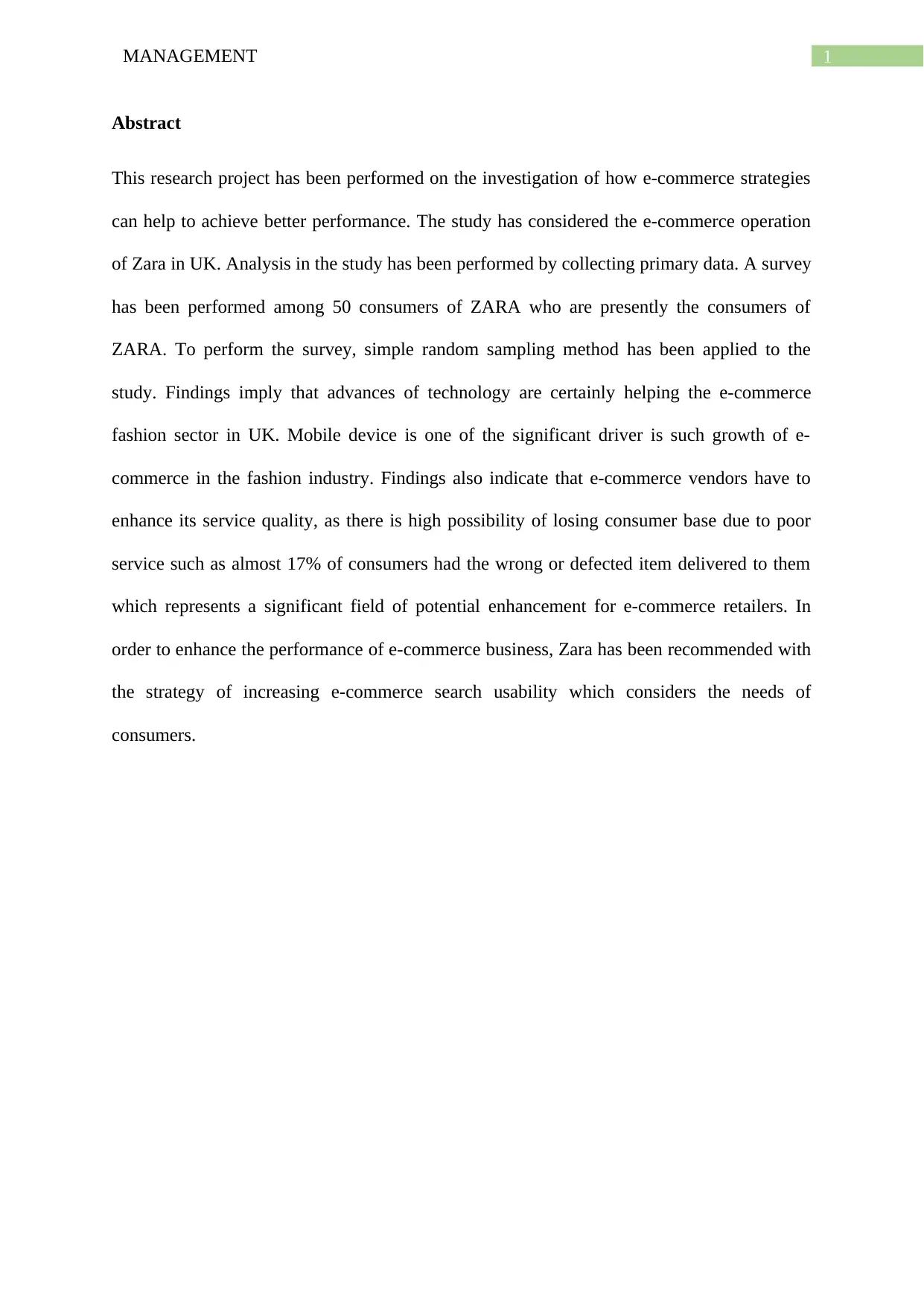
1MANAGEMENT
Abstract
This research project has been performed on the investigation of how e-commerce strategies
can help to achieve better performance. The study has considered the e-commerce operation
of Zara in UK. Analysis in the study has been performed by collecting primary data. A survey
has been performed among 50 consumers of ZARA who are presently the consumers of
ZARA. To perform the survey, simple random sampling method has been applied to the
study. Findings imply that advances of technology are certainly helping the e-commerce
fashion sector in UK. Mobile device is one of the significant driver is such growth of e-
commerce in the fashion industry. Findings also indicate that e-commerce vendors have to
enhance its service quality, as there is high possibility of losing consumer base due to poor
service such as almost 17% of consumers had the wrong or defected item delivered to them
which represents a significant field of potential enhancement for e-commerce retailers. In
order to enhance the performance of e-commerce business, Zara has been recommended with
the strategy of increasing e-commerce search usability which considers the needs of
consumers.
Abstract
This research project has been performed on the investigation of how e-commerce strategies
can help to achieve better performance. The study has considered the e-commerce operation
of Zara in UK. Analysis in the study has been performed by collecting primary data. A survey
has been performed among 50 consumers of ZARA who are presently the consumers of
ZARA. To perform the survey, simple random sampling method has been applied to the
study. Findings imply that advances of technology are certainly helping the e-commerce
fashion sector in UK. Mobile device is one of the significant driver is such growth of e-
commerce in the fashion industry. Findings also indicate that e-commerce vendors have to
enhance its service quality, as there is high possibility of losing consumer base due to poor
service such as almost 17% of consumers had the wrong or defected item delivered to them
which represents a significant field of potential enhancement for e-commerce retailers. In
order to enhance the performance of e-commerce business, Zara has been recommended with
the strategy of increasing e-commerce search usability which considers the needs of
consumers.
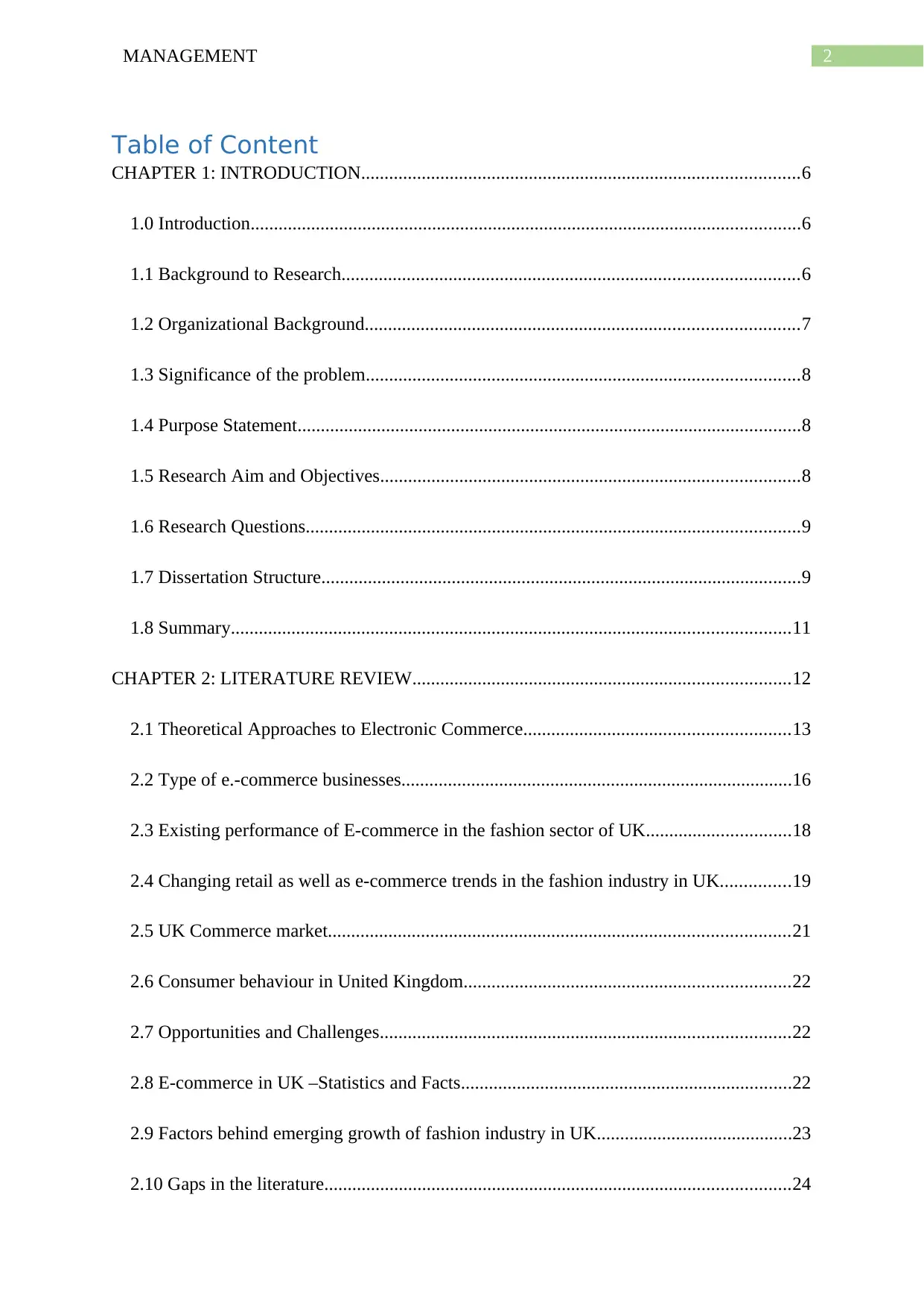
2MANAGEMENT
Table of Content
CHAPTER 1: INTRODUCTION..............................................................................................6
1.0 Introduction......................................................................................................................6
1.1 Background to Research..................................................................................................6
1.2 Organizational Background.............................................................................................7
1.3 Significance of the problem.............................................................................................8
1.4 Purpose Statement............................................................................................................8
1.5 Research Aim and Objectives..........................................................................................8
1.6 Research Questions..........................................................................................................9
1.7 Dissertation Structure.......................................................................................................9
1.8 Summary........................................................................................................................11
CHAPTER 2: LITERATURE REVIEW.................................................................................12
2.1 Theoretical Approaches to Electronic Commerce.........................................................13
2.2 Type of e.-commerce businesses....................................................................................16
2.3 Existing performance of E-commerce in the fashion sector of UK...............................18
2.4 Changing retail as well as e-commerce trends in the fashion industry in UK...............19
2.5 UK Commerce market...................................................................................................21
2.6 Consumer behaviour in United Kingdom......................................................................22
2.7 Opportunities and Challenges........................................................................................22
2.8 E-commerce in UK –Statistics and Facts.......................................................................22
2.9 Factors behind emerging growth of fashion industry in UK..........................................23
2.10 Gaps in the literature....................................................................................................24
Table of Content
CHAPTER 1: INTRODUCTION..............................................................................................6
1.0 Introduction......................................................................................................................6
1.1 Background to Research..................................................................................................6
1.2 Organizational Background.............................................................................................7
1.3 Significance of the problem.............................................................................................8
1.4 Purpose Statement............................................................................................................8
1.5 Research Aim and Objectives..........................................................................................8
1.6 Research Questions..........................................................................................................9
1.7 Dissertation Structure.......................................................................................................9
1.8 Summary........................................................................................................................11
CHAPTER 2: LITERATURE REVIEW.................................................................................12
2.1 Theoretical Approaches to Electronic Commerce.........................................................13
2.2 Type of e.-commerce businesses....................................................................................16
2.3 Existing performance of E-commerce in the fashion sector of UK...............................18
2.4 Changing retail as well as e-commerce trends in the fashion industry in UK...............19
2.5 UK Commerce market...................................................................................................21
2.6 Consumer behaviour in United Kingdom......................................................................22
2.7 Opportunities and Challenges........................................................................................22
2.8 E-commerce in UK –Statistics and Facts.......................................................................22
2.9 Factors behind emerging growth of fashion industry in UK..........................................23
2.10 Gaps in the literature....................................................................................................24
⊘ This is a preview!⊘
Do you want full access?
Subscribe today to unlock all pages.

Trusted by 1+ million students worldwide
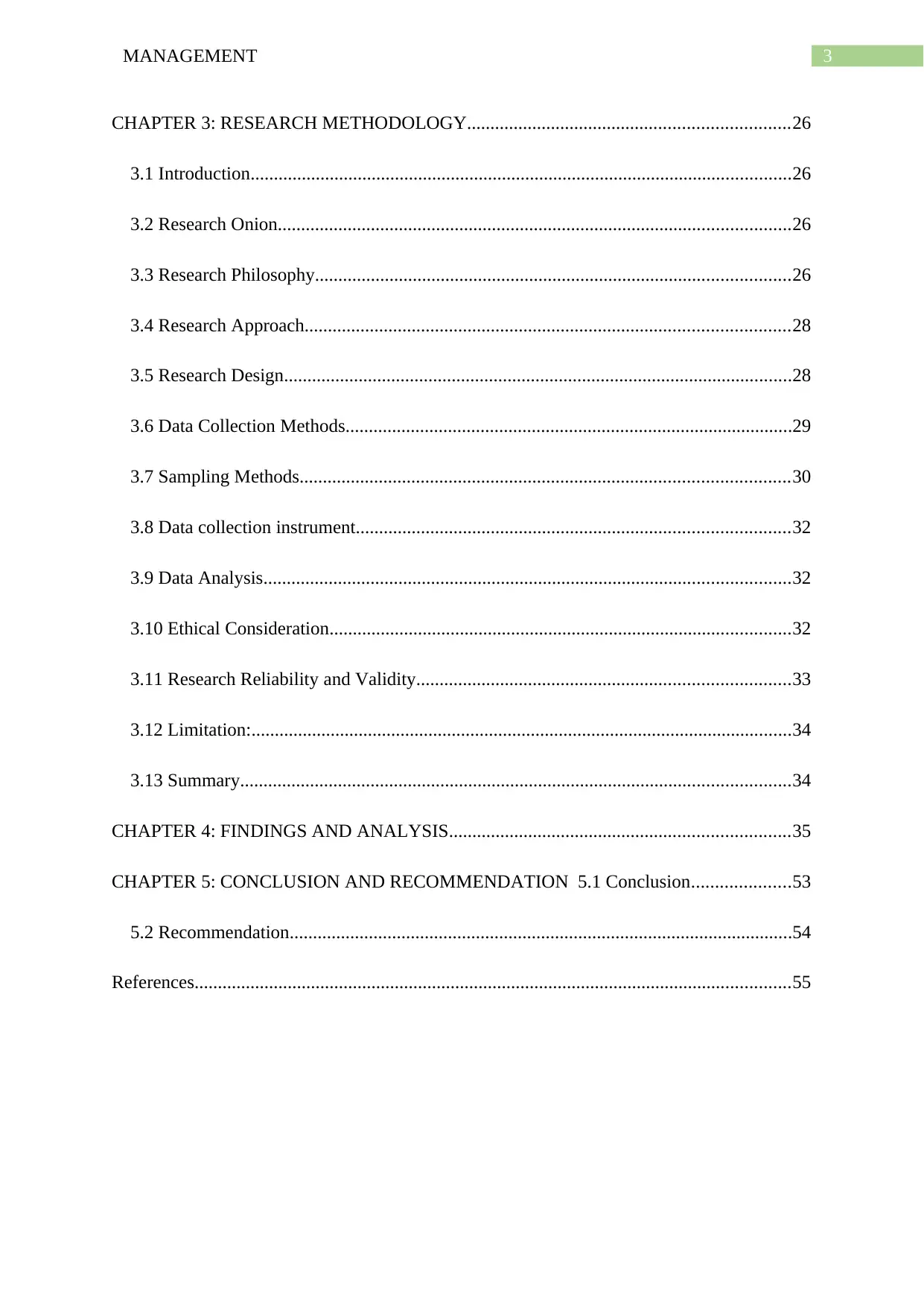
3MANAGEMENT
CHAPTER 3: RESEARCH METHODOLOGY.....................................................................26
3.1 Introduction....................................................................................................................26
3.2 Research Onion..............................................................................................................26
3.3 Research Philosophy......................................................................................................26
3.4 Research Approach........................................................................................................28
3.5 Research Design.............................................................................................................28
3.6 Data Collection Methods................................................................................................29
3.7 Sampling Methods.........................................................................................................30
3.8 Data collection instrument.............................................................................................32
3.9 Data Analysis.................................................................................................................32
3.10 Ethical Consideration...................................................................................................32
3.11 Research Reliability and Validity................................................................................33
3.12 Limitation:....................................................................................................................34
3.13 Summary......................................................................................................................34
CHAPTER 4: FINDINGS AND ANALYSIS.........................................................................35
CHAPTER 5: CONCLUSION AND RECOMMENDATION 5.1 Conclusion.....................53
5.2 Recommendation............................................................................................................54
References................................................................................................................................55
CHAPTER 3: RESEARCH METHODOLOGY.....................................................................26
3.1 Introduction....................................................................................................................26
3.2 Research Onion..............................................................................................................26
3.3 Research Philosophy......................................................................................................26
3.4 Research Approach........................................................................................................28
3.5 Research Design.............................................................................................................28
3.6 Data Collection Methods................................................................................................29
3.7 Sampling Methods.........................................................................................................30
3.8 Data collection instrument.............................................................................................32
3.9 Data Analysis.................................................................................................................32
3.10 Ethical Consideration...................................................................................................32
3.11 Research Reliability and Validity................................................................................33
3.12 Limitation:....................................................................................................................34
3.13 Summary......................................................................................................................34
CHAPTER 4: FINDINGS AND ANALYSIS.........................................................................35
CHAPTER 5: CONCLUSION AND RECOMMENDATION 5.1 Conclusion.....................53
5.2 Recommendation............................................................................................................54
References................................................................................................................................55
Paraphrase This Document
Need a fresh take? Get an instant paraphrase of this document with our AI Paraphraser
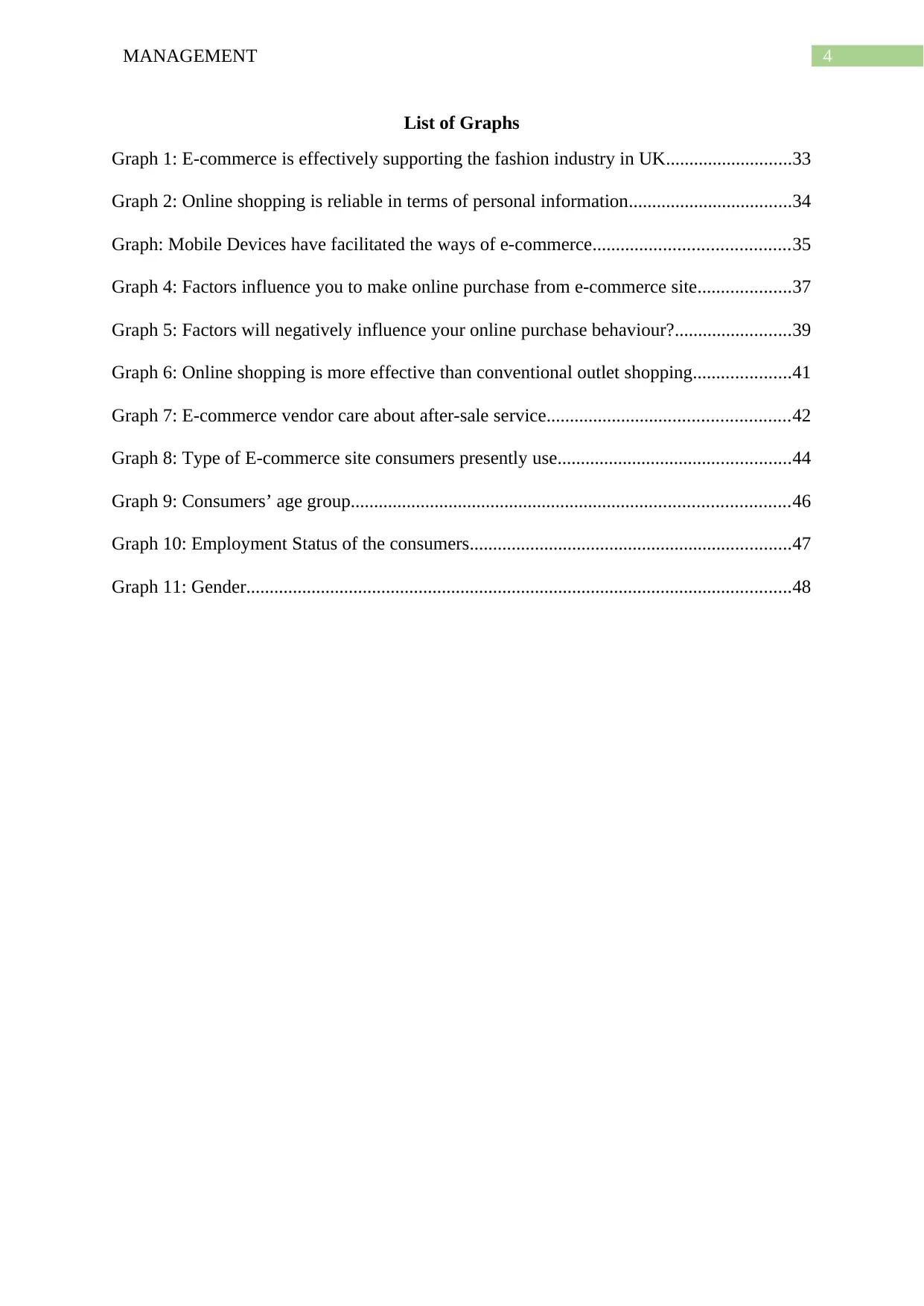
4MANAGEMENT
List of Graphs
Graph 1: E-commerce is effectively supporting the fashion industry in UK...........................33
Graph 2: Online shopping is reliable in terms of personal information...................................34
Graph: Mobile Devices have facilitated the ways of e-commerce..........................................35
Graph 4: Factors influence you to make online purchase from e-commerce site....................37
Graph 5: Factors will negatively influence your online purchase behaviour?.........................39
Graph 6: Online shopping is more effective than conventional outlet shopping.....................41
Graph 7: E-commerce vendor care about after-sale service....................................................42
Graph 8: Type of E-commerce site consumers presently use..................................................44
Graph 9: Consumers’ age group..............................................................................................46
Graph 10: Employment Status of the consumers.....................................................................47
Graph 11: Gender.....................................................................................................................48
List of Graphs
Graph 1: E-commerce is effectively supporting the fashion industry in UK...........................33
Graph 2: Online shopping is reliable in terms of personal information...................................34
Graph: Mobile Devices have facilitated the ways of e-commerce..........................................35
Graph 4: Factors influence you to make online purchase from e-commerce site....................37
Graph 5: Factors will negatively influence your online purchase behaviour?.........................39
Graph 6: Online shopping is more effective than conventional outlet shopping.....................41
Graph 7: E-commerce vendor care about after-sale service....................................................42
Graph 8: Type of E-commerce site consumers presently use..................................................44
Graph 9: Consumers’ age group..............................................................................................46
Graph 10: Employment Status of the consumers.....................................................................47
Graph 11: Gender.....................................................................................................................48
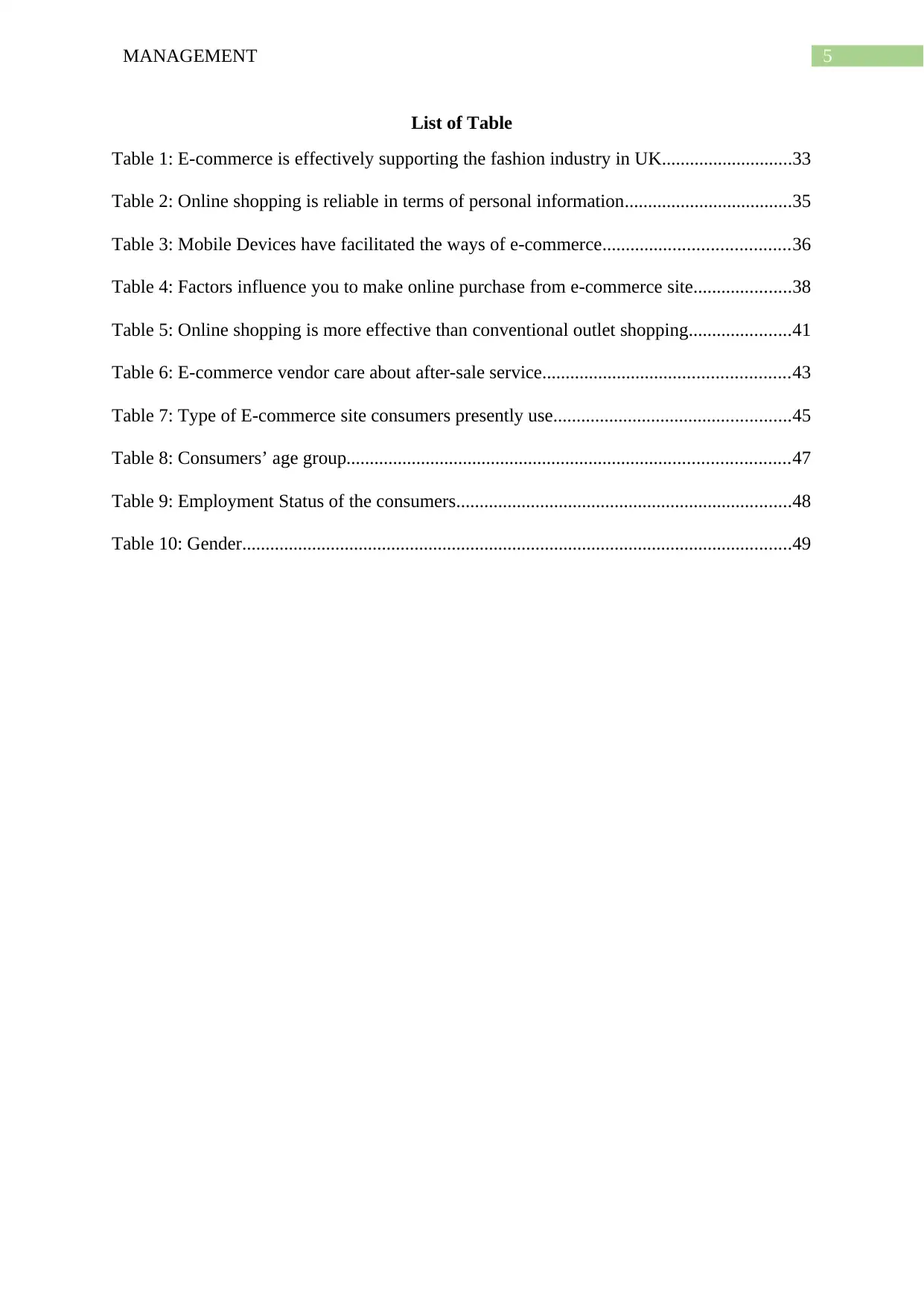
5MANAGEMENT
List of Table
Table 1: E-commerce is effectively supporting the fashion industry in UK............................33
Table 2: Online shopping is reliable in terms of personal information....................................35
Table 3: Mobile Devices have facilitated the ways of e-commerce........................................36
Table 4: Factors influence you to make online purchase from e-commerce site.....................38
Table 5: Online shopping is more effective than conventional outlet shopping......................41
Table 6: E-commerce vendor care about after-sale service.....................................................43
Table 7: Type of E-commerce site consumers presently use...................................................45
Table 8: Consumers’ age group...............................................................................................47
Table 9: Employment Status of the consumers........................................................................48
Table 10: Gender......................................................................................................................49
List of Table
Table 1: E-commerce is effectively supporting the fashion industry in UK............................33
Table 2: Online shopping is reliable in terms of personal information....................................35
Table 3: Mobile Devices have facilitated the ways of e-commerce........................................36
Table 4: Factors influence you to make online purchase from e-commerce site.....................38
Table 5: Online shopping is more effective than conventional outlet shopping......................41
Table 6: E-commerce vendor care about after-sale service.....................................................43
Table 7: Type of E-commerce site consumers presently use...................................................45
Table 8: Consumers’ age group...............................................................................................47
Table 9: Employment Status of the consumers........................................................................48
Table 10: Gender......................................................................................................................49
⊘ This is a preview!⊘
Do you want full access?
Subscribe today to unlock all pages.

Trusted by 1+ million students worldwide
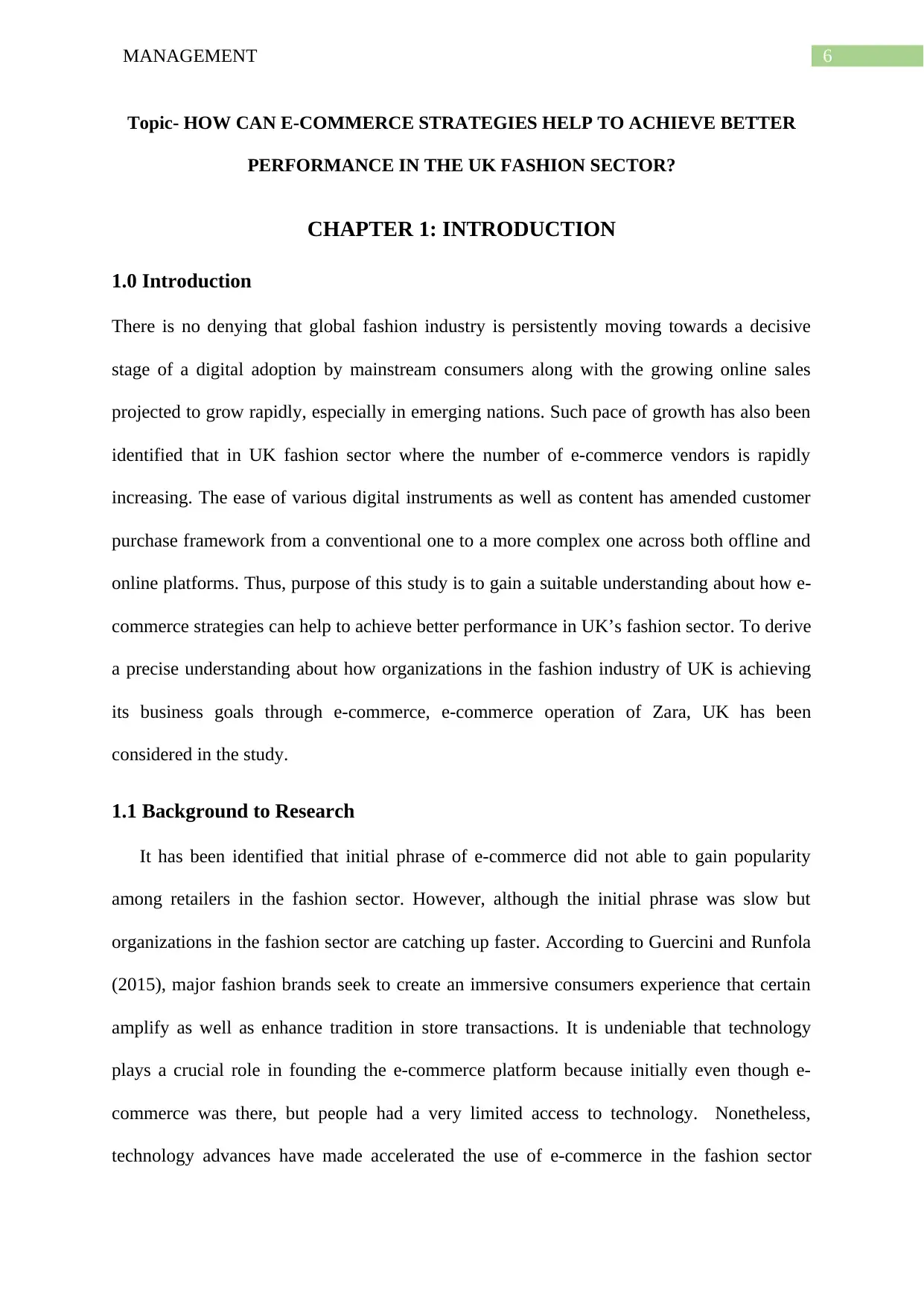
6MANAGEMENT
Topic- HOW CAN E-COMMERCE STRATEGIES HELP TO ACHIEVE BETTER
PERFORMANCE IN THE UK FASHION SECTOR?
CHAPTER 1: INTRODUCTION
1.0 Introduction
There is no denying that global fashion industry is persistently moving towards a decisive
stage of a digital adoption by mainstream consumers along with the growing online sales
projected to grow rapidly, especially in emerging nations. Such pace of growth has also been
identified that in UK fashion sector where the number of e-commerce vendors is rapidly
increasing. The ease of various digital instruments as well as content has amended customer
purchase framework from a conventional one to a more complex one across both offline and
online platforms. Thus, purpose of this study is to gain a suitable understanding about how e-
commerce strategies can help to achieve better performance in UK’s fashion sector. To derive
a precise understanding about how organizations in the fashion industry of UK is achieving
its business goals through e-commerce, e-commerce operation of Zara, UK has been
considered in the study.
1.1 Background to Research
It has been identified that initial phrase of e-commerce did not able to gain popularity
among retailers in the fashion sector. However, although the initial phrase was slow but
organizations in the fashion sector are catching up faster. According to Guercini and Runfola
(2015), major fashion brands seek to create an immersive consumers experience that certain
amplify as well as enhance tradition in store transactions. It is undeniable that technology
plays a crucial role in founding the e-commerce platform because initially even though e-
commerce was there, but people had a very limited access to technology. Nonetheless,
technology advances have made accelerated the use of e-commerce in the fashion sector
Topic- HOW CAN E-COMMERCE STRATEGIES HELP TO ACHIEVE BETTER
PERFORMANCE IN THE UK FASHION SECTOR?
CHAPTER 1: INTRODUCTION
1.0 Introduction
There is no denying that global fashion industry is persistently moving towards a decisive
stage of a digital adoption by mainstream consumers along with the growing online sales
projected to grow rapidly, especially in emerging nations. Such pace of growth has also been
identified that in UK fashion sector where the number of e-commerce vendors is rapidly
increasing. The ease of various digital instruments as well as content has amended customer
purchase framework from a conventional one to a more complex one across both offline and
online platforms. Thus, purpose of this study is to gain a suitable understanding about how e-
commerce strategies can help to achieve better performance in UK’s fashion sector. To derive
a precise understanding about how organizations in the fashion industry of UK is achieving
its business goals through e-commerce, e-commerce operation of Zara, UK has been
considered in the study.
1.1 Background to Research
It has been identified that initial phrase of e-commerce did not able to gain popularity
among retailers in the fashion sector. However, although the initial phrase was slow but
organizations in the fashion sector are catching up faster. According to Guercini and Runfola
(2015), major fashion brands seek to create an immersive consumers experience that certain
amplify as well as enhance tradition in store transactions. It is undeniable that technology
plays a crucial role in founding the e-commerce platform because initially even though e-
commerce was there, but people had a very limited access to technology. Nonetheless,
technology advances have made accelerated the use of e-commerce in the fashion sector
Paraphrase This Document
Need a fresh take? Get an instant paraphrase of this document with our AI Paraphraser
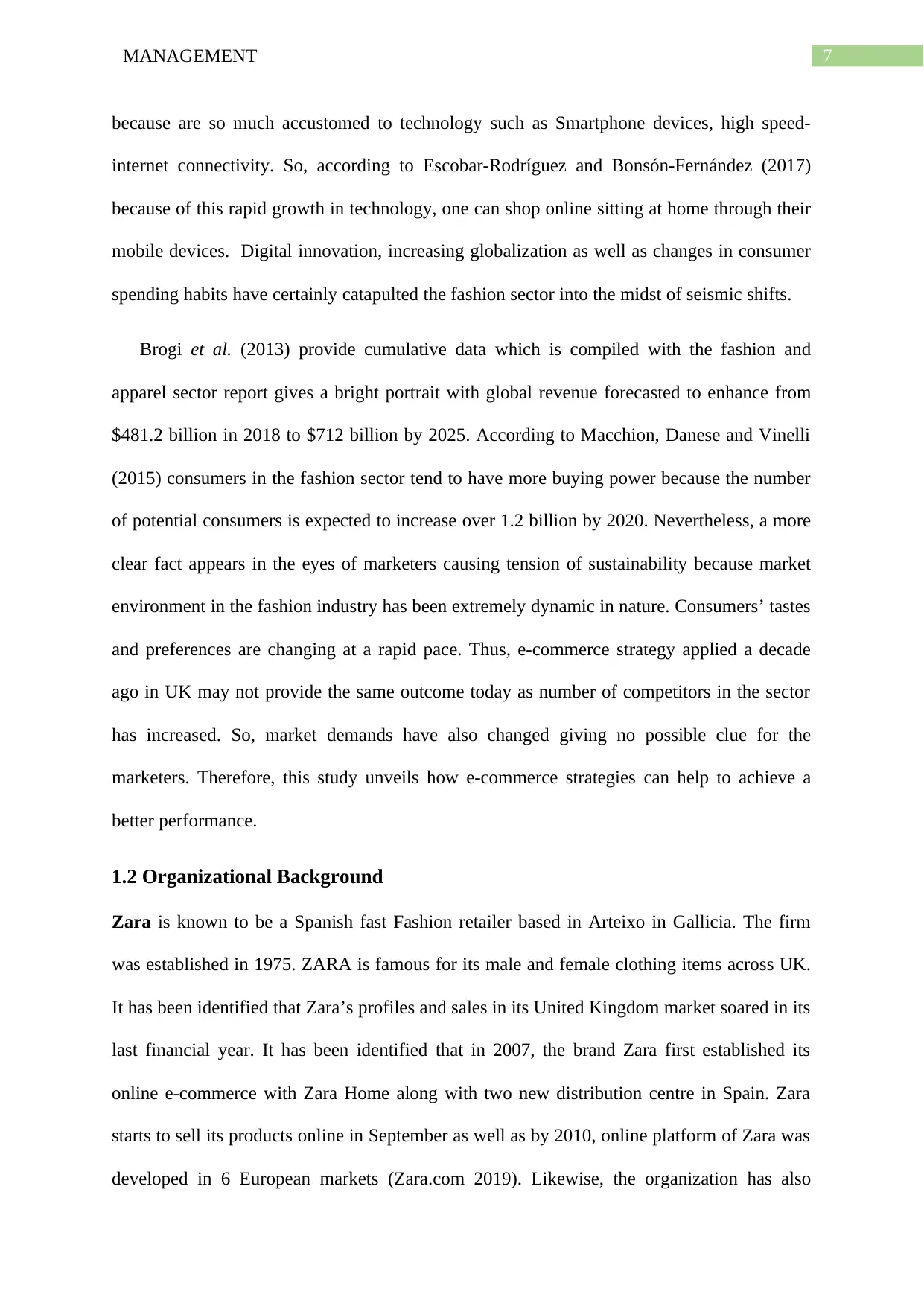
7MANAGEMENT
because are so much accustomed to technology such as Smartphone devices, high speed-
internet connectivity. So, according to Escobar-Rodríguez and Bonsón-Fernández (2017)
because of this rapid growth in technology, one can shop online sitting at home through their
mobile devices. Digital innovation, increasing globalization as well as changes in consumer
spending habits have certainly catapulted the fashion sector into the midst of seismic shifts.
Brogi et al. (2013) provide cumulative data which is compiled with the fashion and
apparel sector report gives a bright portrait with global revenue forecasted to enhance from
$481.2 billion in 2018 to $712 billion by 2025. According to Macchion, Danese and Vinelli
(2015) consumers in the fashion sector tend to have more buying power because the number
of potential consumers is expected to increase over 1.2 billion by 2020. Nevertheless, a more
clear fact appears in the eyes of marketers causing tension of sustainability because market
environment in the fashion industry has been extremely dynamic in nature. Consumers’ tastes
and preferences are changing at a rapid pace. Thus, e-commerce strategy applied a decade
ago in UK may not provide the same outcome today as number of competitors in the sector
has increased. So, market demands have also changed giving no possible clue for the
marketers. Therefore, this study unveils how e-commerce strategies can help to achieve a
better performance.
1.2 Organizational Background
Zara is known to be a Spanish fast Fashion retailer based in Arteixo in Gallicia. The firm
was established in 1975. ZARA is famous for its male and female clothing items across UK.
It has been identified that Zara’s profiles and sales in its United Kingdom market soared in its
last financial year. It has been identified that in 2007, the brand Zara first established its
online e-commerce with Zara Home along with two new distribution centre in Spain. Zara
starts to sell its products online in September as well as by 2010, online platform of Zara was
developed in 6 European markets (Zara.com 2019). Likewise, the organization has also
because are so much accustomed to technology such as Smartphone devices, high speed-
internet connectivity. So, according to Escobar-Rodríguez and Bonsón-Fernández (2017)
because of this rapid growth in technology, one can shop online sitting at home through their
mobile devices. Digital innovation, increasing globalization as well as changes in consumer
spending habits have certainly catapulted the fashion sector into the midst of seismic shifts.
Brogi et al. (2013) provide cumulative data which is compiled with the fashion and
apparel sector report gives a bright portrait with global revenue forecasted to enhance from
$481.2 billion in 2018 to $712 billion by 2025. According to Macchion, Danese and Vinelli
(2015) consumers in the fashion sector tend to have more buying power because the number
of potential consumers is expected to increase over 1.2 billion by 2020. Nevertheless, a more
clear fact appears in the eyes of marketers causing tension of sustainability because market
environment in the fashion industry has been extremely dynamic in nature. Consumers’ tastes
and preferences are changing at a rapid pace. Thus, e-commerce strategy applied a decade
ago in UK may not provide the same outcome today as number of competitors in the sector
has increased. So, market demands have also changed giving no possible clue for the
marketers. Therefore, this study unveils how e-commerce strategies can help to achieve a
better performance.
1.2 Organizational Background
Zara is known to be a Spanish fast Fashion retailer based in Arteixo in Gallicia. The firm
was established in 1975. ZARA is famous for its male and female clothing items across UK.
It has been identified that Zara’s profiles and sales in its United Kingdom market soared in its
last financial year. It has been identified that in 2007, the brand Zara first established its
online e-commerce with Zara Home along with two new distribution centre in Spain. Zara
starts to sell its products online in September as well as by 2010, online platform of Zara was
developed in 6 European markets (Zara.com 2019). Likewise, the organization has also
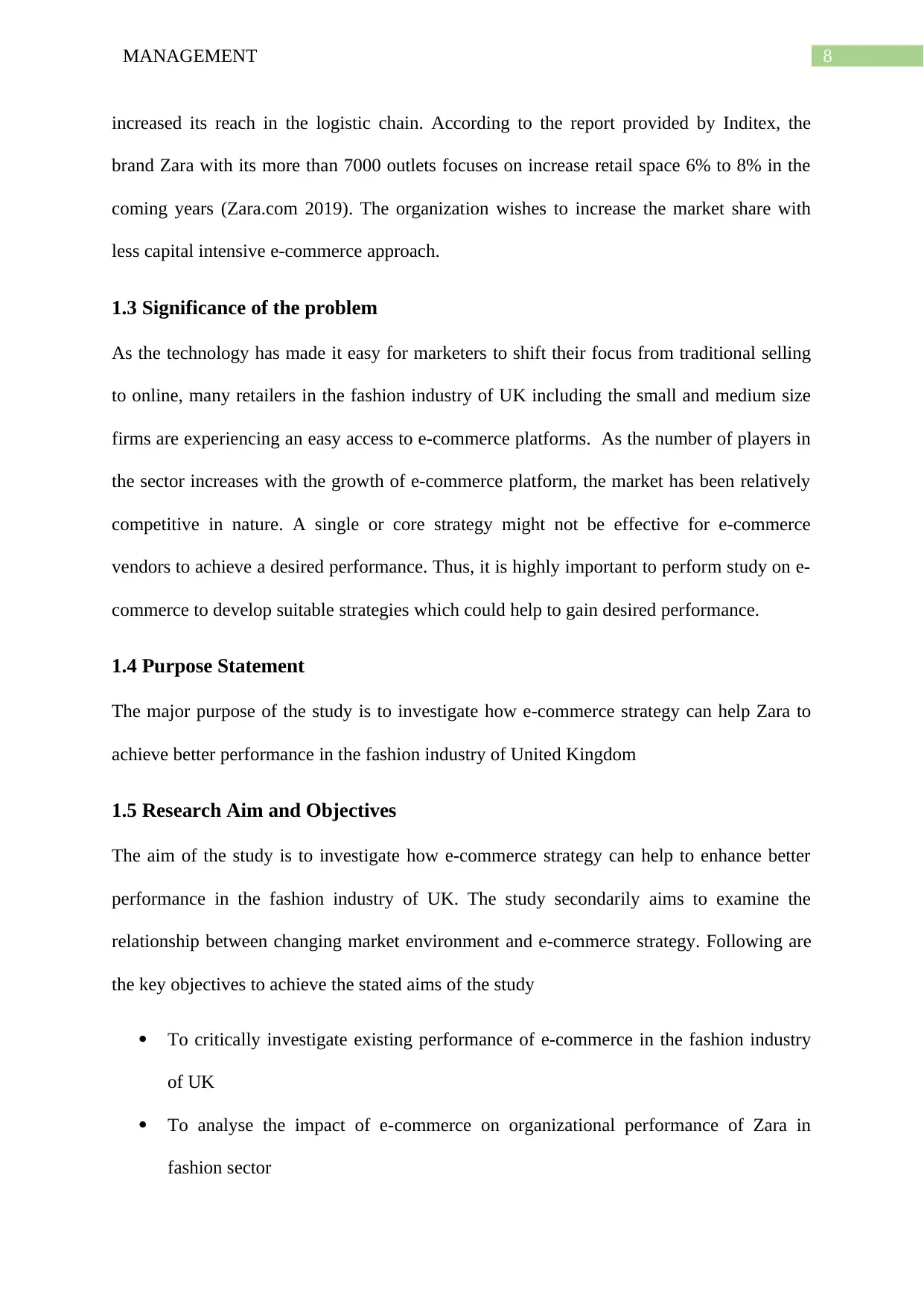
8MANAGEMENT
increased its reach in the logistic chain. According to the report provided by Inditex, the
brand Zara with its more than 7000 outlets focuses on increase retail space 6% to 8% in the
coming years (Zara.com 2019). The organization wishes to increase the market share with
less capital intensive e-commerce approach.
1.3 Significance of the problem
As the technology has made it easy for marketers to shift their focus from traditional selling
to online, many retailers in the fashion industry of UK including the small and medium size
firms are experiencing an easy access to e-commerce platforms. As the number of players in
the sector increases with the growth of e-commerce platform, the market has been relatively
competitive in nature. A single or core strategy might not be effective for e-commerce
vendors to achieve a desired performance. Thus, it is highly important to perform study on e-
commerce to develop suitable strategies which could help to gain desired performance.
1.4 Purpose Statement
The major purpose of the study is to investigate how e-commerce strategy can help Zara to
achieve better performance in the fashion industry of United Kingdom
1.5 Research Aim and Objectives
The aim of the study is to investigate how e-commerce strategy can help to enhance better
performance in the fashion industry of UK. The study secondarily aims to examine the
relationship between changing market environment and e-commerce strategy. Following are
the key objectives to achieve the stated aims of the study
To critically investigate existing performance of e-commerce in the fashion industry
of UK
To analyse the impact of e-commerce on organizational performance of Zara in
fashion sector
increased its reach in the logistic chain. According to the report provided by Inditex, the
brand Zara with its more than 7000 outlets focuses on increase retail space 6% to 8% in the
coming years (Zara.com 2019). The organization wishes to increase the market share with
less capital intensive e-commerce approach.
1.3 Significance of the problem
As the technology has made it easy for marketers to shift their focus from traditional selling
to online, many retailers in the fashion industry of UK including the small and medium size
firms are experiencing an easy access to e-commerce platforms. As the number of players in
the sector increases with the growth of e-commerce platform, the market has been relatively
competitive in nature. A single or core strategy might not be effective for e-commerce
vendors to achieve a desired performance. Thus, it is highly important to perform study on e-
commerce to develop suitable strategies which could help to gain desired performance.
1.4 Purpose Statement
The major purpose of the study is to investigate how e-commerce strategy can help Zara to
achieve better performance in the fashion industry of United Kingdom
1.5 Research Aim and Objectives
The aim of the study is to investigate how e-commerce strategy can help to enhance better
performance in the fashion industry of UK. The study secondarily aims to examine the
relationship between changing market environment and e-commerce strategy. Following are
the key objectives to achieve the stated aims of the study
To critically investigate existing performance of e-commerce in the fashion industry
of UK
To analyse the impact of e-commerce on organizational performance of Zara in
fashion sector
⊘ This is a preview!⊘
Do you want full access?
Subscribe today to unlock all pages.

Trusted by 1+ million students worldwide

9MANAGEMENT
To assess the organizational performance of Zara after the implementation of e-
commerce strategies
To develop suitable e-commerce strategies to enhance e-commerce performance for
Zara in the fashion sector of UK
1.6 Research Questions
What is the existing performance of Zara in the fashion industry?
What is the impact of e-commerce strategies on the organizational performance of
Zara?
How e-commerce strategies can be develop to enhance performance of fashion
industry in UK?
1.7 Dissertation Structure
Chapter 1: Introduction
This chapter of the dissertation introduces the topic and importance of performing a study on
e-commerce in fashion industry. Chapter provides clear aim and objectives based on which
review of literature has been performed in the following chapter. Moreover, the chapter is
also organized with research problems –such as the number of players in the sector increases
with the growth of e-commerce platform, the market has been relatively competitive in
nature.
To assess the organizational performance of Zara after the implementation of e-
commerce strategies
To develop suitable e-commerce strategies to enhance e-commerce performance for
Zara in the fashion sector of UK
1.6 Research Questions
What is the existing performance of Zara in the fashion industry?
What is the impact of e-commerce strategies on the organizational performance of
Zara?
How e-commerce strategies can be develop to enhance performance of fashion
industry in UK?
1.7 Dissertation Structure
Chapter 1: Introduction
This chapter of the dissertation introduces the topic and importance of performing a study on
e-commerce in fashion industry. Chapter provides clear aim and objectives based on which
review of literature has been performed in the following chapter. Moreover, the chapter is
also organized with research problems –such as the number of players in the sector increases
with the growth of e-commerce platform, the market has been relatively competitive in
nature.
Paraphrase This Document
Need a fresh take? Get an instant paraphrase of this document with our AI Paraphraser
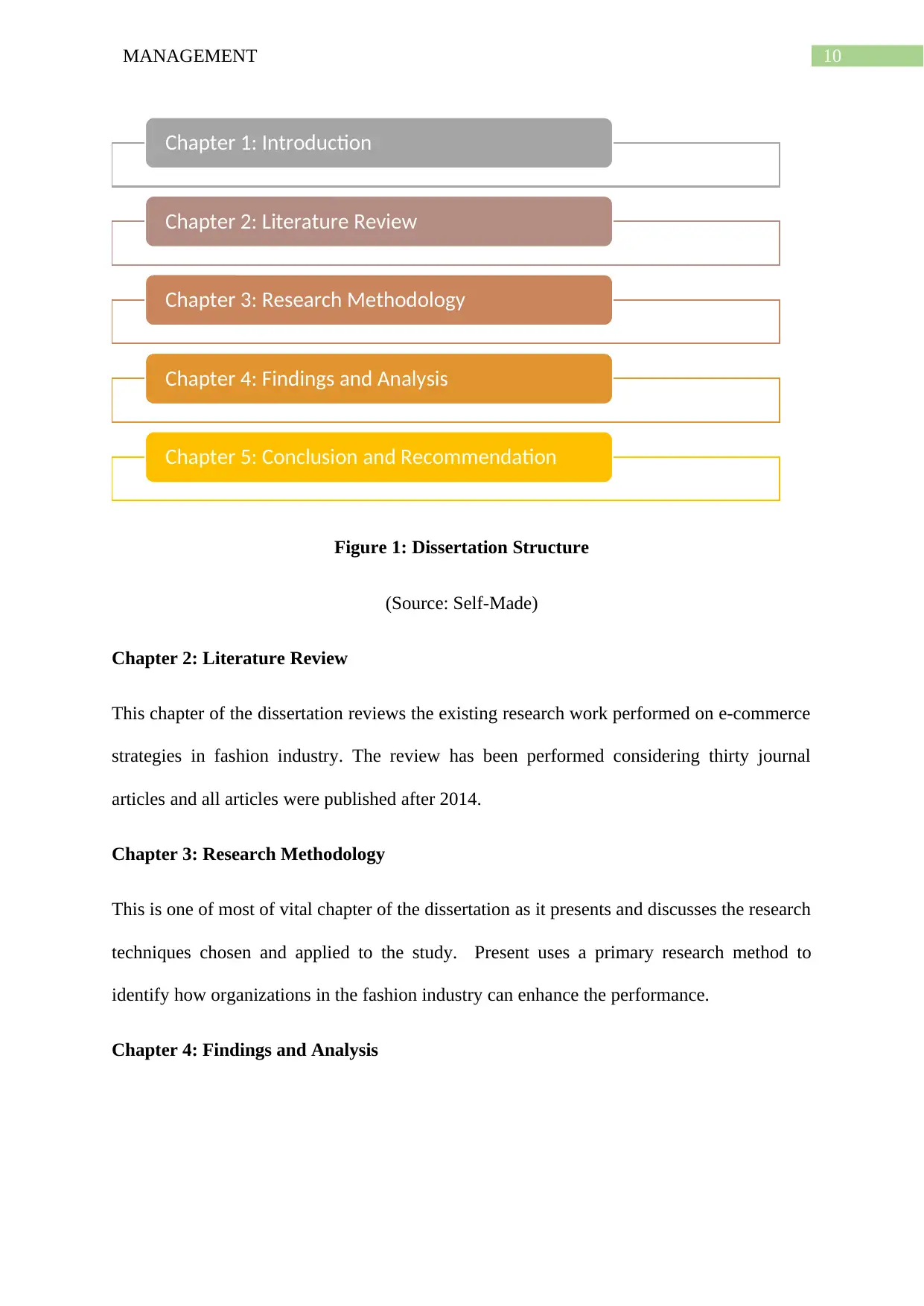
10MANAGEMENT
Figure 1: Dissertation Structure
(Source: Self-Made)
Chapter 2: Literature Review
This chapter of the dissertation reviews the existing research work performed on e-commerce
strategies in fashion industry. The review has been performed considering thirty journal
articles and all articles were published after 2014.
Chapter 3: Research Methodology
This is one of most of vital chapter of the dissertation as it presents and discusses the research
techniques chosen and applied to the study. Present uses a primary research method to
identify how organizations in the fashion industry can enhance the performance.
Chapter 4: Findings and Analysis
Chapter 1: Introduction
Chapter 2: Literature Review
Chapter 3: Research Methodology
Chapter 4: Findings and Analysis
Chapter 5: Conclusion and Recommendation
Figure 1: Dissertation Structure
(Source: Self-Made)
Chapter 2: Literature Review
This chapter of the dissertation reviews the existing research work performed on e-commerce
strategies in fashion industry. The review has been performed considering thirty journal
articles and all articles were published after 2014.
Chapter 3: Research Methodology
This is one of most of vital chapter of the dissertation as it presents and discusses the research
techniques chosen and applied to the study. Present uses a primary research method to
identify how organizations in the fashion industry can enhance the performance.
Chapter 4: Findings and Analysis
Chapter 1: Introduction
Chapter 2: Literature Review
Chapter 3: Research Methodology
Chapter 4: Findings and Analysis
Chapter 5: Conclusion and Recommendation
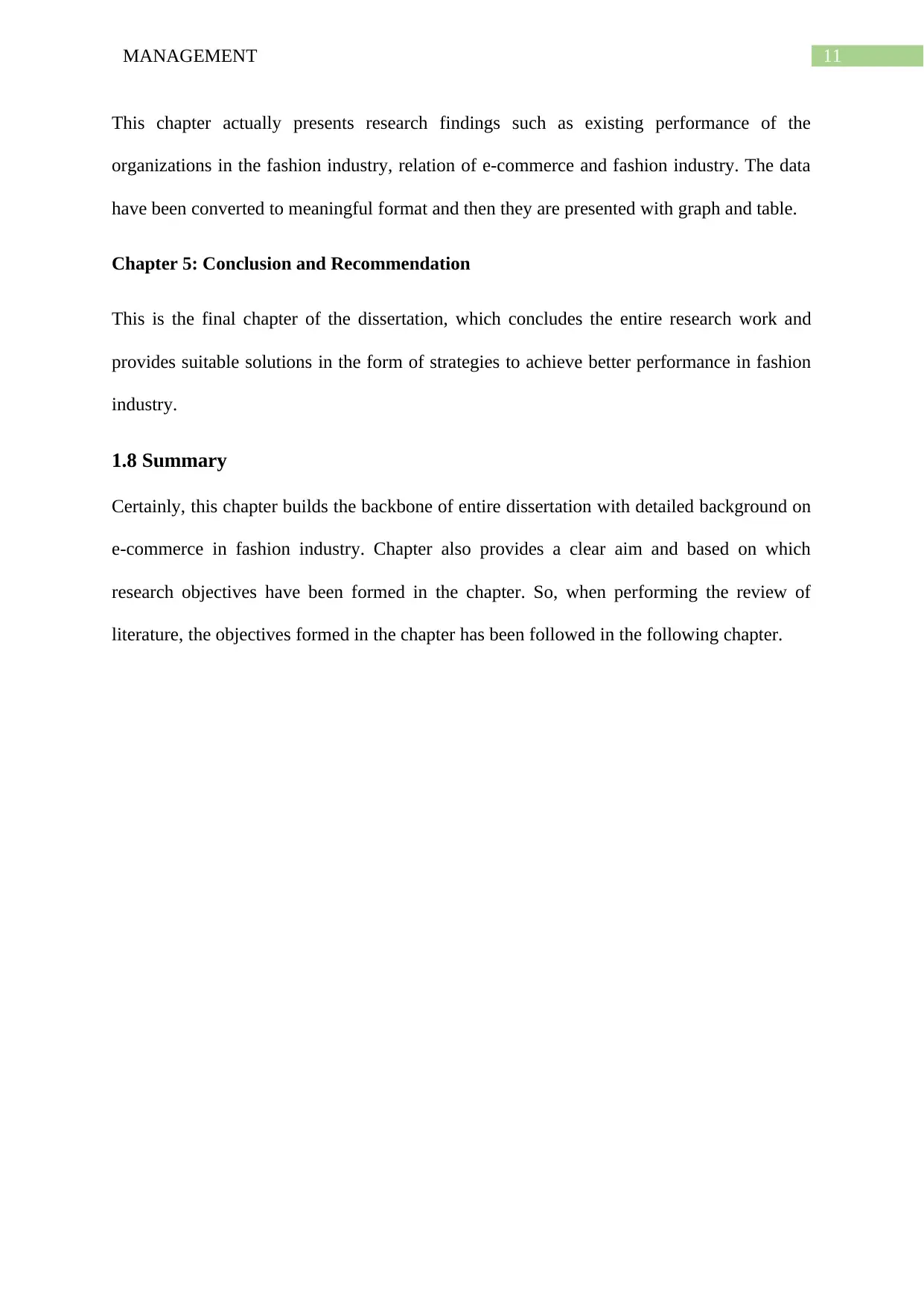
11MANAGEMENT
This chapter actually presents research findings such as existing performance of the
organizations in the fashion industry, relation of e-commerce and fashion industry. The data
have been converted to meaningful format and then they are presented with graph and table.
Chapter 5: Conclusion and Recommendation
This is the final chapter of the dissertation, which concludes the entire research work and
provides suitable solutions in the form of strategies to achieve better performance in fashion
industry.
1.8 Summary
Certainly, this chapter builds the backbone of entire dissertation with detailed background on
e-commerce in fashion industry. Chapter also provides a clear aim and based on which
research objectives have been formed in the chapter. So, when performing the review of
literature, the objectives formed in the chapter has been followed in the following chapter.
This chapter actually presents research findings such as existing performance of the
organizations in the fashion industry, relation of e-commerce and fashion industry. The data
have been converted to meaningful format and then they are presented with graph and table.
Chapter 5: Conclusion and Recommendation
This is the final chapter of the dissertation, which concludes the entire research work and
provides suitable solutions in the form of strategies to achieve better performance in fashion
industry.
1.8 Summary
Certainly, this chapter builds the backbone of entire dissertation with detailed background on
e-commerce in fashion industry. Chapter also provides a clear aim and based on which
research objectives have been formed in the chapter. So, when performing the review of
literature, the objectives formed in the chapter has been followed in the following chapter.
⊘ This is a preview!⊘
Do you want full access?
Subscribe today to unlock all pages.

Trusted by 1+ million students worldwide
1 out of 62
Related Documents
Your All-in-One AI-Powered Toolkit for Academic Success.
+13062052269
info@desklib.com
Available 24*7 on WhatsApp / Email
![[object Object]](/_next/static/media/star-bottom.7253800d.svg)
Unlock your academic potential
Copyright © 2020–2026 A2Z Services. All Rights Reserved. Developed and managed by ZUCOL.




